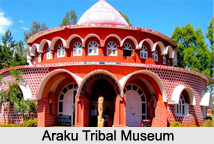 Archaeological museum of Sarnath is the oldest site museum of Archaeological Survey of India. In order to keep the antiquities found from the site, a decision was taken in 1904 by the Government to construct a site museum adjacent to the excavated site at Sarnath. It was due to initiative of Sir John Marshall the then Director General of Archaeology in India, that this museum was created.
Archaeological museum of Sarnath is the oldest site museum of Archaeological Survey of India. In order to keep the antiquities found from the site, a decision was taken in 1904 by the Government to construct a site museum adjacent to the excavated site at Sarnath. It was due to initiative of Sir John Marshall the then Director General of Archaeology in India, that this museum was created.
Sarnath museum exhibits the enormous lion capital which is now the emblem of independent India. It is carved in pale yellowish-grey sandstone with black flecks; the sculpture has the characteristic highly polished surface. At the entrance hall are two figures of Buddha, one of which portrays the historic events at Sarnath. There are many other Buddha and bodhisattva figures on view. Among these the most outstanding is the Gupta period Buddha with hand raised in Abhaya or protection.
The Sarnath Museum has a small but amazing collection of Buddhist artefacts. Among the things to see is a beautiful sculpture of Lord Buddha from the 5th century. The Buddha sits cross-legged, with eyes downcast in deep meditation, and a halo around his head. The stone sculptures from the site of Sarnath are divided in several museums, the major chunk being in the local museum. The Director General of Archaeological Survey of India has loaned some pieces discovered from Sarnath to this museum. They represent deities of the Buddhist and Brahmanical pantheons.

Of other Buddhist remains there is an impressive and amazingly beautiful, life-size standing Bodhisattva and a delicate image of the Bodhisattva with a lotus and yet another bronze sculpture showing the Bodhisattva with multiple arms. The museum at Sarnath also houses an excellent collection of figures and sculptures from the Mauryan, the Kushana and the Gupta periods. Prominent of them is the earliest Buddha image found at Sarnath and many images of Hindu Gods dating from the 9th to 12th centuries. Sarnath has yielded a rich collection of sculptures, artefacts and edifices comprising numerous Buddha and Bodhisattva images and other ancient remains. To house all the findings and excavations at Sarnath, the Archaeological Survey of India established a site Museum at Sarnath. Finest specimens of Buddhist art and other important remains have been housed at the museum. While the single most famous display of this museum is the lion capital, the Sarnath museum has a small but awe-inspiring collection of Buddhist artefacts. Among the things to see is a beautiful sculpture of the Buddha from the fifth century. The Buddha sits cross-legged, with eyes downcast in deep meditation, and a halo around his head. There are several beautiful figures of the several beautiful bodhisattvas.













